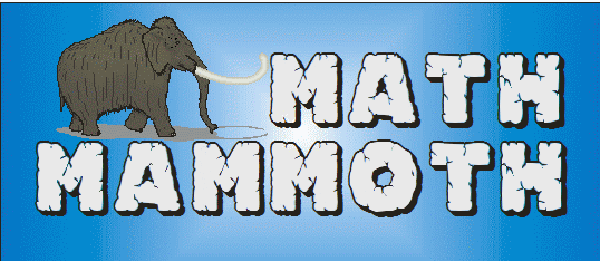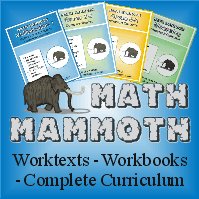








 A few years ago I met a new homeschool Mom named Annette. Filled with enthusiasm and energy she seemed to inspire everyone she talked to. I loved our conversations as Annette always seemed to be an endless fount of information and great ideas.
A few years ago I met a new homeschool Mom named Annette. Filled with enthusiasm and energy she seemed to inspire everyone she talked to. I loved our conversations as Annette always seemed to be an endless fount of information and great ideas.






 Facts marked in green note the rating of "excellent", yellow equals "good", red notes "needs work" and blue dashed lines mark the fact as "not sure yet".
Facts marked in green note the rating of "excellent", yellow equals "good", red notes "needs work" and blue dashed lines mark the fact as "not sure yet". lesson Facts First rewards students with "arcade" time. A visit to the arcade simply means more computer math games to play focused around a carnival theme. Arcade time is timed and even when in the middle of a really great game a message of "times up" appears and the user is re-directed back to the lessons. I thought this feature was good, allowing me the freedom to set my little computer nut loose with Facts First trusting his time would be well spent.
lesson Facts First rewards students with "arcade" time. A visit to the arcade simply means more computer math games to play focused around a carnival theme. Arcade time is timed and even when in the middle of a really great game a message of "times up" appears and the user is re-directed back to the lessons. I thought this feature was good, allowing me the freedom to set my little computer nut loose with Facts First trusting his time would be well spent. 

MathScore rewards speed and therefore to enable maximum success students need to have basic computer keyboarding skills. To assist with this issue, the first topic or lesson to complete is the Copy Cat Topic which teaches using the number key pad. This aspect was especially important for my 2nd grader who did not have much experience with keyboarding skills. Once Sierra successfully completed the Copy Cat Topic a screen appeared which said, "Congratulations" and small fireworks exploded. She was also promoted to the next level of expertise, that of Trainee and was so impressed by this that she ran to me shouting, "Mommy! I completed the level! I've been PROMOTED!" Wow! Excitement over math practice equals a very good thing.
I was pleased my 2nd grader was motivated, but in my opinion the true test of this product was to appeal to my somewhat skeptical 7th grader. I sat down with Micah after she had been using MathScore for three weeks to have her show me around the website and share her honest opinions.
After Micah logged in with her student user name and password she chose "Topics" to begin. A list of 92 different topics are available to choose from for the 7th grade level. Users can choose to review the list alphabetically, show only the critical thinking topics or simply leave them as presented. Once a topic is chosen, users may elect to view a mini-lesson, practice a worksheet of problems relating to the topic or simply do a worksheet. Timed worksheets vary in difficulty and length; the more difficult the concept the fewer the problems and more time awarded to complete. Students work against a designated time to solve problems and once successful in completing the worksheet are awarded points and promoted to the next level or higher. For example, while working on the "Fraction Division" topic, Micah completed level 4 worksheet in record time, was awarded 75 points and promoted to level 7. MathScore read her speed in level 4 as proficiency and rewarded her accordingly. This aspect of the program ensured Micah didn't waste time reviewing mastered concepts.
"They usually make you jump up a level if you have more time left than the time you've spent", explained Micah.
There are many aspects of MathScore which encourage students to pursue more math study. A "High Scores" section lists students using MathScore who have achieved the most points while using the program. Students are simply identified by initials, rank and score. An "Awards" section records the various levels of accomplishment the student has met throughout the entire subscription time with MathScore. All students begin as Trainees and unlock various rankings as points are scored. For example, at 27, 904 points Micah was ranked as a Lieutenant and would move to the next ranking at 30,000 points. The ability to print her list of accomplishment was a nice feature if I desired to have a written record of time well spent. Finally, in addition to points and rankings students can be awarded virtual "trophies" as certain topics are mastered.
"I think it makes it more fun to earn points and move up in ranking,"commented Micah. "It's kind of addicting, actually", she added.
A "Statistics" section of the website detailed a summary of Micah's activity on MathScore. By choosing to click on this button I quickly learned that she had spent a total of 23 hours and 59 mins. in math practice over a three week period. As her parent I also received daily report summaries through email each and every day she spent time on the site noting the updates to her status.
Although, we did not take advantage of the math assessment feature of MathScore, students in grade 4 and older may take an assessment test on the site which identifys student strengths and weaknesses. At the conclusion of the assessment, MathScore recommends topics to be studied based on test results. Assessments are an optional part of the MathScore program and recommended to be taken only a few times a year. Concentrating on working through the math topics is the intended focus of MathScore.
I have reviewed quite a few math related websites over the past two years. I really like the simplicity of MathScore; the competitive nature which taps kids' natural motivation and the accountability aspect of reporting activity to me on a daily basis. Micah was able to use this product without any assistance from me, but I was able to keep tabs on her progress through the email updates and quick checks of her summary. The fact that she completed her traditional math lesson quickly so she could spend more time with MathScore is in my opinion high praise for an educational product geared to mastery not entertainment.
MathScore has a rather complex pricing system in an attempt to meet the unique needs of homeschoolers.